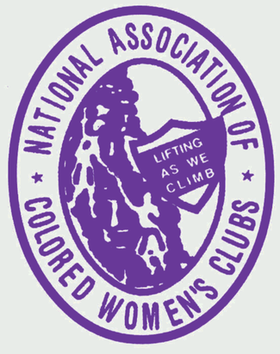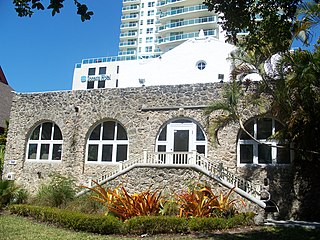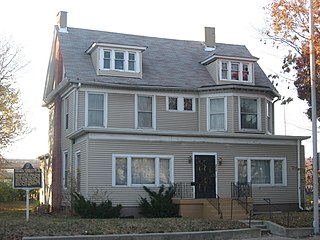
The National Association of Colored Women's Clubs (NACWC) is an American organization that was formed in July 1896 at the First Annual Convention of the National Federation of Afro-American Women in Washington, D.C., United States, by a merger of the National Federation of Afro-American Women, the Woman's Era Club of Boston, and the Colored Women's League of Washington, DC, at the call of Josephine St. Pierre Ruffin. From 1896 to 1904 it was known as the National Association of Colored Women (NACW). It adopted the motto "Lifting as we climb", to demonstrate to "an ignorant and suspicious world that our aims and interests are identical with those of all good aspiring women." When incorporated in 1904, NACW became known as the National Association of Colored Women's Clubs (NACWC).

The Woman's Club of Palmetto is a women's club and is also the name of its historic building in Palmetto, Florida. It is located at 910 Sixth Street West. The building was added to the National Register of Historic Places in March 1986.

The Woman's Club of Winter Park is a historic woman's club in Winter Park, Florida. It is located at 419 Interlachen Avenue. On May 4, 1995, it was added to the U.S. National Register of Historic Places.

The Lemon Bay Woman's Club is a historic woman's club in Englewood, Florida, United States. It is located at 51 North Maple Street. On August 11, 1988, it was added to the U.S. National Register of Historic Places.
The Lemon Bay Woman's club was organized by Dr. Mary Green who was a school teacher in Englewood. Originally named the Lemon Bay Mother's Club, a name retained until April 1924, the club played an important role in the development of the religious, educational, civic and political life of Englewood. Construction on the prairie style clubhouse was begun in September 1925 on two lots donated in Lampp subdivision by A. Stanley and Winifred E. Lampp. Englewood, incorporated in 1925, and the surrounding area then boasted 300 residents.
Sarasota architects Thomas Reed Martin and Clare C, Hosmer, formerly of Chicago, donated their design services for the building. Carpenters Pat Lampp, Fred Clark, and Leroy Bastedo were responsible for the clubhouse construction. The building originally consisted of a screened veranda and one large meeting room featuring a brick fireplace and a semi-circular stage, for which total construction cost was 3,120. A housewarming held on February 19, 1926, attracted 200 persons. Official incorporation, a year later, occurred under the direction of Charlotte Wellington, president.
In 1922, under the leadership of Mrs. Hallie Green, members started a school library and maintained a lending library at the club until 1962. Surviving the depression and the loss of its $37 treasury when banks failed, the club continued to hold fish fries, nature study classes, dances, card parties, plays, musical programs, travelogues and lectures. The club retired its mortgage on February 24, 1938. The note was burned at a gala meeting on March 4, 1938
Between 1926 and 1970, the club served as a sanctuary for many Englewood churches and as a meeting place for various organizations. The Englewood Community Church was the first congregation to meet at the club. Others included the Community Presbyterian Church, First Baptist Church, St. Raphael's Catholic Church, St. David's Episcopal Church, Evangelical Free Church, Church of God, Church of Christ, First Methodist Church, and Calvary Baptist Church. During World War II the building was turned over to the American Red Cross. The club was the first building in Englewood to be listed in the National Register of Historic Places.

The Sarasota Woman's Club is a historic woman's club in Sarasota, Florida. It is located at 1241 North Palm Avenue. It was founded in 1913 and on January 18, 1985, it was added to the U.S. National Register of Historic Places. The clubhouse is now home to the Keating Theater, the mainstage of Florida Studio Theatre.

The Woman's Club of Coconut Grove is a historic woman's club in Miami, Florida.

The Ossoli Circle is a women's club located in Knoxville, Tennessee, United States. Founded in 1885 as a literary society, the club is a charter member of the General Federation of Women's Clubs, and the first federated women's club in the South. Ossoli has long played an active role in obtaining economic and educational opportunities for women in Tennessee, and its members campaigned for the passage of the 19th Amendment in the early 1900s. The club currently sponsors over two dozen projects and organizations.

The Coco Plum Woman's Club is a historic women's club located at 1375 Sunset Drive in Coral Gables, Florida. The club was founded in 1912 with eight members; it was named for the local cocoplum fruit. While the club was originally based in one of its members' houses, it built its own clubhouse in 1913. Its historic Mediterranean Revival clubhouse was built in 1926. The club participated in homefront efforts during both World Wars; its work with the American Red Cross during World War II was well-regarded within Florida. During peacetime, the club has served as a community library, a social venue for meetings and dances, a clinic, and a pre-school.

The Ladies Literary Club Clubhouse, at 850 East South Temple St. in Salt Lake City, Utah, was built in 1913. It was designed by architects Treganza & Ware in Prairie School style.
Mercy Hospital was a hospital located at 1344 22nd Street South in the city of St. Petersburg, Florida. The hospital was the only primary care facility for the African-American community of St. Petersburg from 1923 to 1966. It was designed by the local architect Henry Taylor, which has also designed other important structures such as the City Comfort Station, the Vinoy Park Hotel and the Jungle Country Club Hotel. It was constructed by Edgar Weeks in July 1923. Mercy Hospital not only served as a medical facility but also as a site for protesting against the segregation of the other hospitals in the city during the Civil Rights Movement. In 1994, it was declared a Historic Place. The city purchased the facility in 1998 due to a lack of redevelopment and deterioration.*change site Then the city leased the facility to Community Health Centers of Pinellas, Inc., which also runs the Johnnie Ruth Clarke Medical Center.

The Silver City Woman's Club is a historic women's club located at 411 Silver Heights Boulevard in Silver City, New Mexico. The club was founded in 1909, and it built its meeting house in 1935–36. Richard Tatsch designed the clubhouse in the Pueblo Revival style, which reflected the region's architectural history. The clubhouse provided two spaces for the club's community activities and private meetings; the former included distributing food to needy families and conducting child welfare inspections on behalf of the state, while the latter included self-improvement courses in music and literature. The women's club has continuously held its activities in the building since its construction; it has also provided a space for community meetings and large events.

The Woman's Club of El Paso was founded in the late nineteenth century, and during that time was the only woman's organization in El Paso, Texas. The Woman's Club also allowed women in El Paso to become involved in community service and activism. The building which is the home for the club is located on 1400 N. Mesa Drive, and was erected in 1916. The club, now a non-profit organization, traces its official origins back to 1894, and continues to provide an "educational and cultural center for its members." The building is registered in the National Register of Historic Places.

Indiana State Federation of Colored Women's Clubs, also known as the Minor House, is a historic National Association of Colored Women's Clubs clubhouse in Indianapolis, Indiana. The two-and-one-half-story "T"-plan building was originally constructed in 1897 as a private dwelling for John and Sarah Minor; however, since 1927 it has served as the headquarters of the Indiana State Federation of Colored Women's Clubs, a nonprofit group of African American women. The Indiana federation was formally organized on April 27, 1904, in Indianapolis and incorporated in 1927. The group's Colonial Revival style frame building sits on a brick foundation and has a gable roof with hipped dormers. It was listed on the National Register of Historic Places in 1987.

The Tennille Woman's Clubhouse, at 132 Smith St. in Tennille, Georgia, was built in 1922. It was listed on the National Register of Historic Places in 1998.

The Glendale Woman's Club was first organized in 1901 as a “Self Culture Club”, the primary aim of the Woman’s Club was self-improvement from a literary standpoint. They raised money for the first library and city parks. In 1898 the lumber company moved to a new two-story office building; Mr. Messenger could no longer manage the library. A library association was formed. The women’s club bought up stock and then assigned members to vote. Mrs. May Catlin Hanson, through club member Mrs. Lafe Myers, donated a building which was placed in park to house the library until a new one could be built. Mrs. Robert Clark and Mrs. J.M. (Mary) Pearson took the lead. Mary took a class on “Library work” in Phoenix to be able to “start it out right.”. By 1907, membership had increased to fifty members and it became impossible to continue meeting in homes, so the group began to think of acquiring its own clubhouse. On February 21, 1912, exactly 1 week after Arizona became the 48th state, the Club was recognized 501c3 non profit corporation with 85 members. The Glendale Woman's Club is a member of the General Federation of Women's Clubs.

The Woman's Club of Topeka was named as an entity in 1916 but has earlier roots. Its building, located just one-half block west of the Kansas State Capitol and completed in 1925, was listed on the National Register of Historic Places in 1982.

The Woman's Improvement Club Clubhouse in Corona, California, at 1101 S. Main St., was built in 1913. It was listed on the National Register of Historic Places in 1988.

St. Petersburg, Florida, held an election for mayor on August 24, 2021. Incumbent Democratic mayor Rick Kriseman is term-limited and cannot seek re-election to a third term in office. Municipal elections in St. Petersburg are officially nonpartisan. All candidates appeared on the same primary ballot, and because no candidate garnered at least 50% of the vote, the top two vote-getters advanced to a runoff election on November 2, 2021. Former Pinellas County commissioner Ken Welch easily defeated city councillor Robert Blackmon in the runoff and became the first black mayor of St. Petersburg.



















